#transcontinental railroad
Text

Elephant Rock at Monument Point
This can be found along the former roadbed of the Central Pacific. The timetable lists the locale simply as “Monument”. We are twenty-one miles from Promontory Summit here.
Image by Richard Koenig; taken September 7th 2013.
#railroadhistory#railwayhistory#centralpacific#firsttranscontinentalrailroad#transcontinental railroad#monumentutah#utah
25 notes
·
View notes
Text
currently reading After Promontory: 150 Years of Transcontinental Railroading

#after promontory#us history#transcontinental railroad#trains#currently reading#currently reading: after promontory#<<<for the blacklist :)
9 notes
·
View notes
Note
Favorite California history books? Any interesting books on California governors?
First of all, anything by Kevin Starr is a good place to start if you're looking for books on California history. I particularly recommend California: A History (BOOK | KINDLE) for an overall history and Coast of Dreams: California on the Edge, 1990-2003 for a more modern perspective.
Jim Newton's book Man of Tomorrow: The Relentless Life of Jerry Brown (BOOK | KINDLE) is probably the best biography I've read about one of California's most influential Governors. Lou Cannon's Governor Reagan: His Rise to Power (BOOK | KINDLE) is an excellent look at the future President's early political career and eight years in Sacramento.
Mark Arax has written some really insightful books about California's history, culture, and politics, especially West of the West: Dreamers, Believers, Builders, and Killers in the Golden State (BOOK | KINDLE), and The Dreamt Land: Chasing Water and Dust Across California (BOOK | KINDLE).
While they aren't solely about California, I'd also suggest these books, which help tell some of the more important aspects of the story of California: Kearny's March: The Epic Creation of the American West, 1846-1847 (BOOK | KINDLE) by Winston Groom; The Crusades of Cesar Chavez: A Biography (BOOK | KINDLE) by Miriam Pawel; and, Cesar Chavez: Autobiography of La Causa (BOOK | KINDLE) by Jacques E. Levy.
There's another question in my inbox asking for book suggestions about Sacramento, so I'll include those in this answer. Sacramento: An Illustrated History, 1839-1874: From Sutter's Fort to Capital City by Thor Severson is an older book, but really solid about Sacramento's early history. Fool's Gold: A Biography of John Sutter by Richard Dillon, John Sutter: A Life on the North American Frontier by Albert L. Hurtado, and The Associates: Four Capitalists Who Created California (BOOK | KINDLE) by Richard Rayner are good biographies about some of the most important founders of Sacramento.
And you can't tell the story of Sacramento or California (or, really, the United States) without the construction of the transcontinental railroad, so I'd also highly recommend Nothing Like It in the World: The Men Who Built the Transcontinental Railroad, 1863-1869 (BOOK | KINDLE) by Stephen Ambrose, and Empire Express: Building the First Transcontinental Railroad (BOOK | KINDLE) by David Haward Bain.
#History#Books#Book Suggestions#Book Recommendations#California#California History#Sacramento#Sacramento History#Jerry Brown#Governor Brown#Ronald Reagan#Governor Reagan#Transcontinental Railroad#John Sutter#Mark Arax#Kevin Starr
18 notes
·
View notes
Text

(Hung Liu “Portrait of China Mary”, 2006, Oil on canvas)
Currently at The James Museum in St. Pete, is From Far East to West: The Chinese American Frontier, an informative show that includes many beautiful paintings. There’s so much history in America that often doesn’t get taught in school. This is a great opportunity to learn about this immigration story through artwork as well as text.
From the museum about the exhibition-
While European American settlers gradually pushed the United States frontier westward throughout the 1800s, the West coast of the country was developing independently as well. Accelerated by the discovery of gold mid-century, the population boom included Chinese immigrants who crossed the Pacific Ocean to California.
Most 19th century Chinese immigrants came to their new country from the coastal Canton region (province of Guangdong today) in southeastern China. Starting over on a different continent away from familiar surroundings and culture would be challenging, but for many decades anti-Chinese hostility and exclusion laws made settling in the United States even more difficult. The achievements of Chinese immigrants paved a path for future generations and are a testament to strength and perseverance.
The foundation for the exhibition highlights narratives of Chinese America from the 1850s to the 1930s. The paintings-all created by Chinese Americans in the 21st century-reflect inspiration from this history. The painters are also fueled by their own, more recent immigration stories to the United States after China’s Cultural Revolution (1966-1976) and their rigorous art training in the government-sponsored movement of Socialist Realism. After China opened to the rest of the world in the late 1970s, many Chinese artists-like Mian Situ, Jie Wei Zhou, Benjamin Wu, Hung Liu, and Z.S. Liang, all featured here were inspired to immigrate to the United States in search of greater opportunity.
Here, these artists’ historical interpretations speak to culture, identity, community, and resilience. Related objects and ephemera from the period support these stories. From the Gold Rush to Angel Island, this exhibition reveals often overlooked but significant contributions and perspectives of Chinese immigrants that deepen our understanding of U.S. history.

Hung Liu “Dandelion with Small Bird”, 2017 Mixed media
About the above painting from the museum-
Dandelions and their fluffy seed pods can be found anywhere in the world and thrive wherever they land. Their migratory nature allows them to survive a journey across vast lands even across oceans and take root anywhere in the world. For Liu, the dandelion represents her own tenacity and ability to thrive in the face of adversity.
The dandelions, fragile in nature and tattered by the lightest breeze, mimic how images, and personal narratives, too, can be scattered by time and the winds of history —as well as by the rhythms of feast and famine …
–Hung Liu

Mian Situ “Blasting a Route Through the Sierra Nevada, 1865, Central Pacific Railroad”, 2018, Oil on canvas

Mian Situ “The Gold Seekers , Chinese Camp, 1850”, 2015, Oil on canvas

Jie Wei Zhou “Dragon Parade”, 2012, Oil on Linen
This exhibition is on view until 1/28/24.
#Art#The James Museum#Hung Liu#Art Shows#Chinese American History#Mian Situ#Chinese Americans#Florida Art Shows#Gold Rush#Jie Wei Zhou#Z.S. Liang#Benjamin Wu#St. Pete Art Shows#The James Museum of Western and Wildlife Art#Historical Painting#History#Immigration#Painting#Transcontinental Railroad
3 notes
·
View notes
Text

"RUSHING THE C. N. R. LINE FROM PEMBROKE," Ottawa Citizen. October 15, 1913. Page 1.
---
Contractor Expects Steel to be Laid to Portage Du Fort This Fall.
----
J. P. Mullarkey, contractor for the construction of the section of the Canadian Northern transcontinental railway between Ottawa and Pembroke, began to lay steel easterly from Pembroke two days ago. Before the severely cold weather comes, he says, he will have the steel laid as far as Portage du Fort, a distance of 27 miles.
Before the middle of next month the rails will be laid from Ottawa as far as Chats Falls. Then work on the construction of the two bridges over the Ottawa river, one at Portage du Fort and the other at Chats Falls, will be rushed so that the bridges will be completed early next spring.
The entire section of the road in question has been graded and it is planned to have it ready for operation in the fall of next year. The contractors on the sections from Pembroke to North Bay and from North Bay to the C. N. R. line now in operation from Fort William westward are making good headway with their work. Early in 1915, perhaps before then, the whole line from east to west will be ready for traffic.
The length of the C. N. R. route to Pembroke from Ottawa is 86 miles, 36 shorter than the C. P. R. and 22 shorter than the Grand Trunk.
#pembroke#ottawa#railway construction#laying track#canadian northern railway#grand trunk railway#transcontinental railroad#infrastructure construction
1 note
·
View note
Text
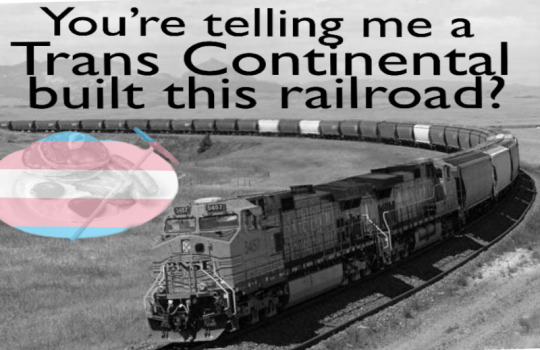
My sister’s in her room reviewing a Zoom lesson about the transcontinental railroad, and this popped into my head.
#trans#lgbt#queer#trans memes#train#railroad#transcontinental railroad#train meme#American history#history meme#breakfast#continental breakfast#trans flag#meme#funny#queer memes#lgbt memes#nerd shit#i’m not sorry
35 notes
·
View notes
Photo

Central Pacific No. 60 Locomotive
The Jupiter was a 4-4-0 steam locomotive owned by the Central Pacific Railroad. It made history when it joined the Union Pacific No. 119 at Promontory Summit, Utah, during the Golden Spike ceremony commemorating the completion of the First transcontinental railroad in 1869.
#locomotives#historic locomotives#historic moments#transcontinental railroad#central pacific railroad#jupiter#trains#visit promontory#travel america#travel photography#traveling#visit utah#utah attractions#muttball
4 notes
·
View notes
Note
unfortunately I have been having the same struggle wrt westerns (the few books I've found that touch well on the actual variance of culture and such have not clicked at all in strength of plot :/ ) but if you're really searching for the Vibe (and yes this is a real stretch) I do recommend what can be had of the lobbyists' in-progress musical 'golden mountain'. there are six songs from it out currently and I do think they get at what you're asking for, or at least they do for me.
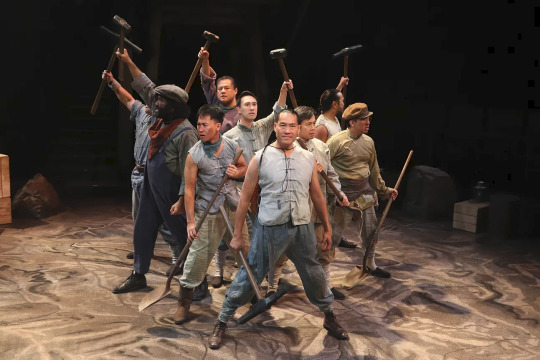
The famous 1869 photograph of the Golden Spike ceremony — Andrew J. Russell’s “East and West Shaking Hands at Laying of Last Rail,” at Promontory Summit in Utah — focused sharply on white people as the builders of the railroad. You can’t discern any Chinese workers in the glassplate exposure. But some 20,000 Chinese immigrants were key to the building of the rails, which essentially laid the foundation for a modern United States of America.
Ooh this does look promising! It gets into what I was talking about with stories from the Wild West that are actually based in its diverse reality and are super interesting. I'll go take a look at it, thanks!
1 note
·
View note
Text

Most depictions of Chinese transcontinental railroad workers have a bunch of humble looking guys in conical straw hats all wearing the same baggy shirt carrying buckets or dynamite or whatever.
I love that this one has this dude who is HELLA JACKED swinging a sledgehammer the force of which sends his queue flying into the air. Dude next to him in Mr T's vest armed with guns for days while smoking a pipe. 10/10.

#transcontinental railroad#representation#trains#chinese americans#chinese american history#asian americans#asian american history#hella jacked
1 note
·
View note
Text
Palisade Nevada
Located along the banks of the Humboldt River in Eureka County lies the remains of a railroad town critical to the construction of the Transcontinental Railroad. The townsite was named for Palisade Canyon and located west of town. The narrow canyon is a major barrier in the construction of the railroads. The townsite was plotted in 1868 and served as a train station for the Central Pacific…

View On WordPress
#Central Pacific Railroad#Eureka and Palisade Railroad#Eureka County#Herbert Hoover#Nevada#Nevada State Historic Markers#Nevada State Route 278#Railroad#Transcontinental Railroad#Western Pacific Railroad
0 notes
Text
We talk about the rapid change of technology now. But since Industrialization, that's just how it is.
In 1847, white people going from Iowa to California had to do it in wagons, and whether you made it or not in 6 months was 100% contingent on the weather and how fast you could reload a flintlock. By 1869 they has finished the Transcontinental Railroad, and for 4 days you could massacre buffalo with a repeater rifle from the window of a train over the mountains.
That's 22 years. That is the same amount of time I experienced between watching the first Matrix movie and the big screen adaptation of Dear Evan Hansen.
I mean, there was other more significant stuff that happened between those two movies. But I think you get the point.
...There was also some more significant stuff that happened in America between 1847 and 1869, honestly.
Look. Can I do ONE POST without mentioning 1.6 million dead people?? Jeez.
1 note
·
View note
Text
Dragon Book Cover Makeover: THE THOUSAND CRIMES OF MING TSU
Every Monday, my grumpy dragon Windsor takes over my blog to give books a much needed dragon makeover.
This week, Windsor is giving one of my favorite books from 2021 a makeover: The Thousand Crimes of Ming Tsu by Tom Lin.
As I’ve said, this is one of my favorite books from 2021. It starts off as a straightforward “Old West” novel, but not far into the story, things take more of a “Weird West”…
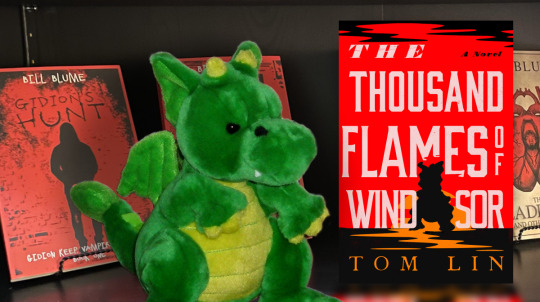
View On WordPress
#book cover#book covers#dragon#Dragon Book Cover Makeover#grumpy dragon#magical realism#Ming Tsu#old west#The Thousand Crimes of Ming Tsu#Tom Lin#transcontinental railroad#weird west#western#Windsor
0 notes
Text
Rolling on the River. . . to a Bridge
How did Lincoln change the course of transportation history four years before he entered the White House?
How Lincoln and Modern Technology Changed History
When the Effie Afton (not pictured) ran into the Rock Island Railroad Bridge stone pier in 1856, exploding in flames and destroying a section of the bridge, it led to the transcontinental railroad. Today people and goods move across the country from the Atlantic Ocean to the Pacific Ocean because of this court case argued in a Chicago courtroom…
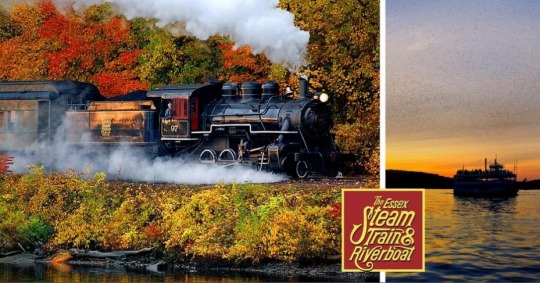
View On WordPress
0 notes
Link
It's time for America's Third Great Awakening. It could happen in a couple of weeks! Pray God for a discerning and humble electorate this time. Read details.
0 notes
Text
Early Railroad Bridges Across the Missouri River
Early Railroad Bridges Across the Missouri River
Although I have a lot of editing to do on my current work-in-progress (the sixth book in my Oregon series), I am beginning to think about the next book. I’m planning for the seventh novel to be the last book in the series, but who knows?
I only have the sketchiest of plots for that novel at this point, but I think railroads will play a part in the story. I want the overall arc of my series to…
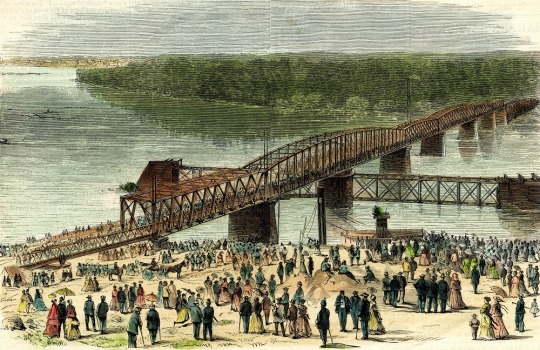
View On WordPress
#Hannibal Bridge#Oregon history#Oregon Trail#railroads#Transcontinental Railroad#Union Pacific Railroad Bridge#writing
0 notes
Text

"HURRICANAW INDUSTRY IS BOOMING," Cobalt Daily Nugget. December 23, 1913. Page 1.
---
Name to be Changed to Amos Against Wishes Of People
----
(From Our own Correspondent.)
COCHRANE, Dec. 3 - Mr. Bernard, of Hurricanaw, arrived in town on a train from the east last night. He is here to secure the services of as many men as possible to take back to Hurricanaw for log cutting. Hurricanaw is described by contractors and engineers who know the Transcontinental Railway east of here as "one of the coming towns on the T. C. R. between Winnipeg and Quebec." The town at present is to all intents and purposes confined to the east bank of the river and the north side of the Railway. This year about a hundred settlers came in and great success was gained with the crops of oats by those who had the courage to try the land. Mr. Authier had an exceptionally good crop of oats for a first year on a clay soil and the potatoes were quite phenomenal.
Mr. Fortier, Government Scaler, obtained a crop of potatoes of 26 to 1, and these were of first grade size and quality throughout.
The larger of the two mills belonged formerly to Mr. Paquette, but at the end of November it was purchased by Mr. Blaise, who is increasing his boiler power and will be able to cut 25,000 F.B.M. per day. He has already let contracts for 250,000 logs and is open to take as many more as he can get. Trade should be very flourishing next year as the gold claims at Keniwisick are being developed and a rush is expected at the beginning of 1914. Keniwisick is situated on the Hurricanaw river, about 60 miles South of where the T.C.R. crosses. In the summer it is navigable the whole way for both gasoline boats and small steamboats) Mr. Bernard, chief store-holder, having both running to and from the gold fields with supplies and mining outfit.
It has been decided to change the name from Hurricanaw to Amos, although against the wish of 90 per cent. of the population.
#amos#northern quebec#transcontinental railroad#logging town#railway town#working class town#resource extraction#resource capitalism#gold strike#gold rush#railway construction#settler colonialism in canada
0 notes